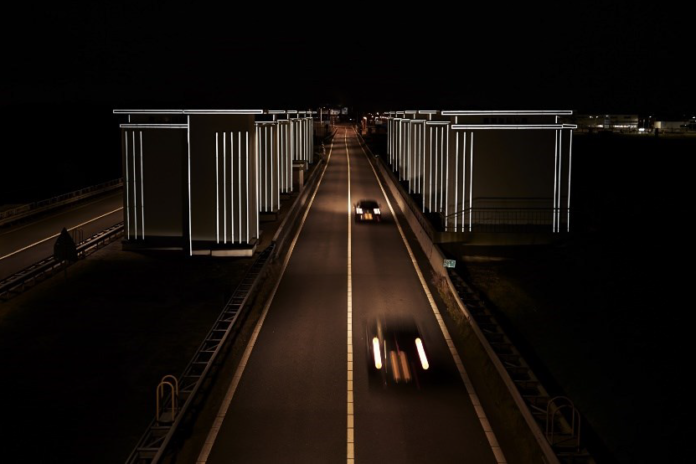Have you seen these incredible glowing gates by architect/artist Daan Roosegaarde and his team? The Afsluitdijk highway hasn’t been the same since.
For just over three years now, the iconic Afsluitdijk highway gates have been permanently lighting up in the dark with each passing car. The interesting thing is that the gates light up perfectly but aren’t using a speck of energy. Instead the architect and his team have used special reflectors that mirror any light exceptionally well. It’s the driver’s own lights that are creating the divine illusion.
The lights are on the “Tower Gates”, which were recently restored to a pristine state as good as they were in ’30’s, which are iconic at both sides of the dike. Their typical Art-Deco style is of course typical of the 1930’s and further underscored in a futuristic manner by the stripes that light up.
The Afsluitdijk — connecting the country, fighting off the North Sea.
The Afsluitdijk is one of Holland’s master engineering projects. They have permanently changed the country, and Europe for that matter, by transforming an in-land sea into one of the continent’s biggest lakes.
Holland had been struggling to keep the North Sea at bay, often dealing with severe flooding, up until an engineer Cornelis Lely came up with a plan to permanently dam in the “Zuiderzee” (Southern Sea) and change it into a much more controllable lake. After a massive flooding in 1916, Lely managed to guide his plans through Dutch parliament and an endless supply of workers, engineers and architects set to work to build his vision: a dike that could defeat a sea.
Unfortunately, Lely passed away before his dream was fully realized. He was found collapsed on the ground before his desk in 1929, while working on a brochure of the Amsterdam-Rijnkanaal.
Honoring Lely and his heritage
Lely however is honored in many places, including a sizeable city located ‘within the lake’ named Lelystad, which was built on land won from the soils of the lake and former sea. Lelystad is located in Flevoland — a province also entirely build on the lake.
Today, the Afsluitdijk is the only shortcut for drivers to reach Noord-Holland from Friesland. It also protects the country faithfully from the North Sea playing any inland tricks and the brackish waters of the Ijsselmeer are unique to both Holland and Europe, having become a wildlife haven for many previously endangered species.
There will also be a number of temporary works, including special fiber glass kites, also glowing in the dark, which generate enough energy from wind power to power approximately two hundred houses.
“Windvogel” (Wind Bird) is dedicated to former astronaut and engineer Wubbo Ockels — the first Dutch national in space — who passed away in 2014. Another work is that of glowing algae, who’s mesmerizing blue hue can be interacted with by visitors.
Roosegaarde, who together with his team designed all of the project for the Dutch government, said, “The Afsluitdijk stands for a piece of Dutch courage and innovation. By adding a subtle layer of light and interaction we’ve strengthened the beauty of the dike and created a new connection between man and landscape, dark and light, poetry and practicality.”
We couldn’t agree more and we hope, if you believe in such a thing, that engineer Cornelis Lely is looking down at the dike with a smile. It’s still just as important as it was nearly a century ago. Thank you, Mr. Lely and thank you design studio Roosegaarde for so beautifully enhancing this bit of national pride!
Have you seen this light installment? Tell us your thoughts in the comments below!
Feature Image: Studio Roosegaarde
Editor’s Note: This article was originally published in November 2017, and was fully updated in December 2020 for your reading pleasure.



My Pa told stories about working on the afsluitdijk construction project before he emigrated to the States. It was a kick to be able to drive on it when I visited.